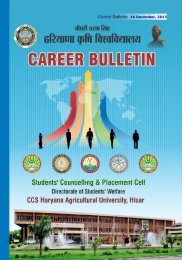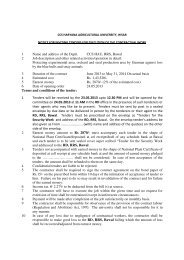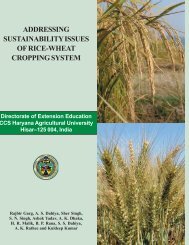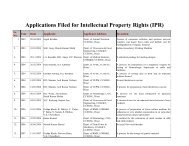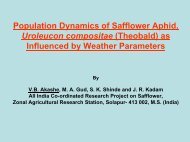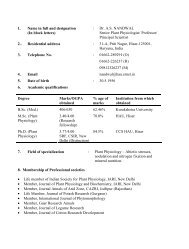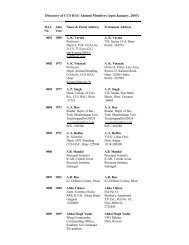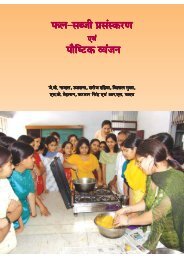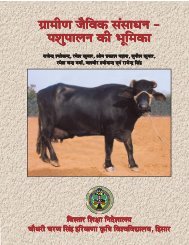Foreword - CCS HAU, Hisar
Foreword - CCS HAU, Hisar
Foreword - CCS HAU, Hisar
Create successful ePaper yourself
Turn your PDF publications into a flip-book with our unique Google optimized e-Paper software.
(iii) Butterflies and moths : Kill the specimens by freezing, wrap lightly in tissue paper,<br />
and place in a crush-proof box. Careful handling is required because the pattern of<br />
scale coloration is often used in identification.<br />
(iv) Caterpillars : Send in alive on some of the host plant tissues in a plastic bag.<br />
Refrigerate until sent.<br />
(v) Grubs: Send in alive in a pint or two of soil enclosed in a plastic bag. Refrigerate<br />
until sent.<br />
(C) Packaging plant and insect samples<br />
It is important to package the samples properly to ensure they arrive in good condition<br />
at the plant clinic. Following are general guidelines for handling and packaging plant and<br />
insect samples.<br />
Use plastic bags<br />
For most samples including leaves, stems and roots, use plastic bags to prevent plant<br />
samples from drying out during transport. However, fleshy fruits, vegetables, or tubers in<br />
stages of decay should be wrapped individually in dry newspaper.<br />
Submit samples as soon as possible<br />
Decayed plant or insect samples are useless for an accurate disease diagnosis. Always<br />
plan to have samples arrive at the Centre within one or two days of their collection, if possible,<br />
or take steps to inhibit the deterioration or decay of samples (i.e., by refrigeration).<br />
Representative, moderate symptoms<br />
Do not submit dead plants for diagnosis. Place roots and soil together in a Plastic bag<br />
and close it securely. Place several branches showing decline or dieback in a separate<br />
plastic bag. For smaller plants, submit an entire plant (confine the root ball in a plastic bag<br />
tied tightly to the stem). Place the entire plant in another plastic bag and close it securely.<br />
Be sure there is no water on the foliage surfaces (this causes deterioration during shipping).<br />
General Packaging Guidelines<br />
1. Take your samples before applying pesticides; otherwise the ability to recover disease<br />
pathogens may be limited.<br />
2. Don’t add water or pack a sample that is wet or in wet paper<br />
3. After your samples are collected keep them refrigerated until submitted.<br />
4. Don’t mix samples in the same submission bag. Moisture from root samples will<br />
contribute to the decay of foliage if they are mixed together.<br />
5. Plant disease identification procedures do not utilize soil. Excess soil can be hand<br />
shaken from root systems.<br />
6. Please mark sample packages with a “Warning” if there are thorns or spines<br />
7. All samples must be accompanied with a completed “Plant Disease Diagnostic Form.”<br />
8. Note recent pesticide history on the form accompanying the sample<br />
9. Samples arriving from sites that are two days or less mailing time from a clinic can be<br />
sealed in plastic bags for shipping<br />
36



